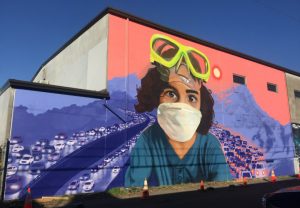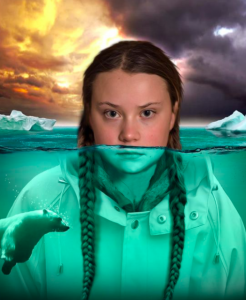16 Activism through Art
Art plays a large role in how humans see and interact with the world and each other. No matter who you are, where you come from and how old you are, it is something that can be enjoyed and interpreted in a variety of ways. Unlike law or politics, things that are learned or take years to understand and practice, creativity is something we all already possess. The use of art in activism is a creative way to bring awareness and make involvement inviting to people of all ages and backgrounds. Activism through art can include music, film, paintings, drawings, photography, and even dressing up.
The concept of turning art into political climate activism is intended to turn data-based representations of the climate crisis into something more vivid and approachable. In Seattle, activism through art is used throughout protests, city murals and community-based programs. Craig Cundiff, a 32-year-old artist in Seattle recently dedicated a mural located in Georgetown to climate activism (https://www.seattlemag.com/arts-and-culture/new-georgetown-protest-mural-takes-climate-change-south-seattle-air-pollution). The mural portrays a young boy, Cundiff’s son, wearing a mask and goggles in front of a mass of cars caught in “Seattle traffic”, and an orange hazy sun shining through the wildfire smoke and pollution.  Cundiff’s “art-with-a-message” doesn’t necessarily contain any words to narrate it, but the message is interpreted by the eyes that read it. There are also community-based programs in Seattle that use art as a way to create young leaders, uplift and bring together low-income communities and people of color, and combat oppression such as Creative Justice and 350Seattle. 350Seattle dedicates a campaign for artistic activism where they share videos and photos of past protests, and songs, chants, and mantras to perform at events. The arts provide 350Seattle support for creative outreach and encourages people to participate despite experience or skills (https://350seattle.org). Creative Justice on the other hand, works toward building community among incarcerated youth by exploring the root of incarceration such as systematic racism and offers art instruction and creation to enhance skills and celebrate the strengths and creativity of young people (https://www.creativejusticenw.org/cj-mission-vision).
Cundiff’s “art-with-a-message” doesn’t necessarily contain any words to narrate it, but the message is interpreted by the eyes that read it. There are also community-based programs in Seattle that use art as a way to create young leaders, uplift and bring together low-income communities and people of color, and combat oppression such as Creative Justice and 350Seattle. 350Seattle dedicates a campaign for artistic activism where they share videos and photos of past protests, and songs, chants, and mantras to perform at events. The arts provide 350Seattle support for creative outreach and encourages people to participate despite experience or skills (https://350seattle.org). Creative Justice on the other hand, works toward building community among incarcerated youth by exploring the root of incarceration such as systematic racism and offers art instruction and creation to enhance skills and celebrate the strengths and creativity of young people (https://www.creativejusticenw.org/cj-mission-vision).
The arts can be a powerful way to encourage climate action and provide a different perspective. Today, the media plays a huge role in swaying opinions. However, there are typically other issues that dominate and hold priority for TV talk shows and news stations. If this is the case, and it is, we should cater to these business interests. If filmmakers, actors and animators highlight the issue of climate change in their own creative ways we can use the media to influence opinion. People act out of having an emotional connection with the environment. If that emotional connection isn’t there, they won’t care.  Producing and promoting art that engages people with the natural environment and inspires others to share their stories can create experiences and encourage human empathy to make this crisis feel more real.
Producing and promoting art that engages people with the natural environment and inspires others to share their stories can create experiences and encourage human empathy to make this crisis feel more real.
Sadly, in the U.S. we are still fighting to prove that climate change is real to some people. However, many web series and films are creating a generation of environmental activists through their productions. “The North Pole” a web series that focuses on three friends facing environmental threats in their hometown is an example of the arts creating an accessible and entertaining way for people to be educated on the climate justice movement and climate change (http://www.thenorthpoleshow.com). Art can be appreciated and interpreted all over the world, especially when it is a crisis that the whole world is facing together. Greta Thunberg a 16-year-old Swedish activist known for challenging leaders all over the world to take immediate action against the climate crisis has served as a symbol for many artists in their artwork.  Jody Thomas an artist from Bristol, London painted a 50-foot mural of Greta Thunberg submerged in rising sea water, with the waterline just high enough to cover her mouth. The mural went viral and serves as a very strong message against the effects of climate change and the importance of using our voices to speak up for change before it is too late (https://news.artnet.com/art-world/greta-thunberg-climate-art-1645336).
Jody Thomas an artist from Bristol, London painted a 50-foot mural of Greta Thunberg submerged in rising sea water, with the waterline just high enough to cover her mouth. The mural went viral and serves as a very strong message against the effects of climate change and the importance of using our voices to speak up for change before it is too late (https://news.artnet.com/art-world/greta-thunberg-climate-art-1645336).
The climate movement is often clouded by exhaustion, burnout and despair. Yet art can give climate activists a chance to keep their cause alive and provide a sense of hope and gratitude. Approaching the climate crisis in a creative way allows us to focus on what is actually changing and why we will miss it when it’s gone. Whether it be through a photograph or a painted mural, taking the time to reflect enhances the sense of urgency within the climate justice movement. The arts act as a healing agent for many and is about a dream of something that has potential. Activism through art has the possibility for transformation, renewal and redemption.
Media Attributions
- pexels-photo-2561628
- georgetown mural 780
- pexels-photo-3004517
- Screen Shot 2020-12-04 at 11.03.12 PM

